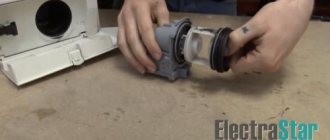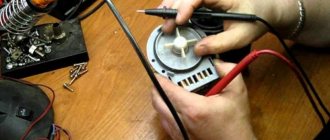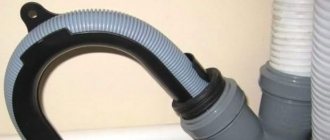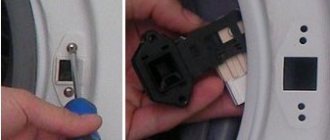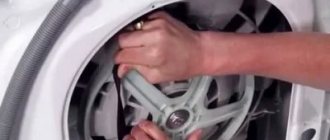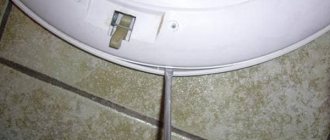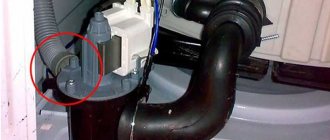All household appliances fail sooner or later, but if to repair an electric lamp it is enough to replace the light bulb, then to restore the functionality of a complex device you will need
have a sufficient amount of free time and the minimum required level of knowledge. A washing machine is just such a product, so self-repair is fraught with many difficulties, especially when it is necessary to disassemble this device for repair.
Often the washing machine pump fails, and if this part cannot be restored, then it must be replaced. To perform this operation, you need to disassemble the washing machine and remove the faulty drainage device.
Washing machine drain mechanism
This operation must be performed strictly in a certain sequence, so before you begin removing this part, you need to know exactly where the drain mechanism is located and how it works correctly.
Drain pump: operating principle
After the end of the washing or rinsing cycle, the electronic control unit sends a signal to the solenoid valve to turn on the drain mechanism. Forced removal of liquid is necessary to reduce washing time, so the washing machine is equipped with a powerful pump that allows you to pump out the entire volume of liquid inside the machine’s tank within a short time.
To prevent small particles from entering the interior, the drain mechanism has a washing machine drain pump filter.
Washing machine drain filter
Thanks to reliable protection against solid objects getting on the impeller, it is possible to achieve a long service life of the pump, but if for some reason such a “fuse” does not work, then even a small plastic button caught in the internal cavity can cause failure of this part.
If the drain of the machine stops working, then it is necessary to check the pump for possible damage. How to check and replace, if necessary, the drain pump on a washing machine will be discussed below.
Purpose of the washing machine drain pump
The water pump is designed in ASM to forcibly remove liquid from the tank at different stages of automatic washing. Structurally, the drain pump looks like this:
- small electric motor;
- shaft;
- impeller (impeller);
- snail, with a pipe connected to it and a drain hose.
Signs of malfunction:
- The automatic washing machine does not perform the rinsing procedure, the washed items are poorly rinsed, the machine does not rinse at all (stops).
- The waste water from the tank is not drained or takes a very long time to drain.
- The spin mode does not turn on.
- After washing, washing powder remains in the dispenser (partially or completely).
Signs of a faulty washing machine pump
In order not to confuse other types of washing machine breakdowns with a pump malfunction, you need to know the main signs by which you can judge that the pump has failed or its life is coming to an end. Most often, this malfunction manifests itself as follows:
- The washing machine makes a lot of noise when draining dirty water.
- The device operates normally, but the liquid is pumped out too slowly.
- The pump hums, but no water comes out at all.
- The “drain” mode is turned on, but while the system is operating, the water drainage process is automatically turned off.
If at least one sign of malfunction is observed, it must be checked. If the pump is clogged, timely cleaning will allow it to fully restore its functionality.
this detail. In order to make a diagnosis, you need to know where the pump is located on the washing machine.
Instructions for replacing your pump in 8 steps
In most cases, repair is not possible. The faulty pump is simply replaced with a new one. Depending on the device configuration, you need:
- Disconnect the car. While the device is powered from the network, it is dangerous to manipulate it.
- Remove water and laundry from the drum. This is also a safety measure and the body will be lighter.
- Open the case. For different models, the outer cover is held on top or at the back. You need to find the securing bolts and unscrew them.
- Find the pump under the drum. It is connected to the drain hoses and the control part with cables and hoses.
- Remove the volute and pump from the housing. Carry out the procedure carefully, the elements are quite fragile.
- Disconnect tubes, terminals, wires. It is recommended to photograph their location in advance so as not to be confused when connecting.
- Connect a new spare part. All elements must be secured in their original places.
- Before closing the housing, it is better to run a short dry wash program. This is necessary to check the functionality of the new pump.
The location of the pump is different in machines with vertical and horizontal loading. The standard location of the part is at the bottom of the drum. Pumps are equipped with terminals and cables through which their structure is powered with electricity.
Replacing a washing machine pump with your own hands does not require any special skills, but there are a number of difficulties during repairs. It is important to select a replacement part of a similar size, preferably from the same manufacturer. If you have no idea about the rules for repairing and replacing the pump, it is better to contact a professional workshop. High-quality repairs will help you avoid even bigger problems, for which you will have to pay more.
Have you decided to do your own repairs? Samodelkin approves! You will find all spare parts with us, each with a guarantee of quality and compatibility.
See all pumps »
Where is the pump located?
Locating the drain mechanism at the front wall of the machine
The drain mechanism can be located in various places of the household appliance. Its location depends on what brand of washing machine was purchased. The pump can be installed:
- In the back of the car (Electrolux and Zanussi)
- Just behind the front cover (AEG, Bosch and Siemens)
- At the bottom of the machine (Whirpool, Samsung, Ariston, Beko, LG)
Having established the exact location of the drain unit, it is necessary to remove the part for inspection.
Gaining access to the pump by removing the front wall
This feature is typical for washing machines from AEG, Bosch, Siemens and Samsung. The process of removing the front panel of the car is similar for these manufacturers. So, let's get to it.
– First of all, remove the top cover. Unscrew a couple of screws and pull it towards you. At the end - slightly up. Next, take out the cuvette for the powder and conditioner. It is pulled all the way and pulled out. If there is a key inside the cuvette, press it and remove it. If not, lift it up and take it out too.
We see two or three screws on the front panel - unscrew them. Now on the top or side of the control panel we find the screws that secure it to the body. They also need to be removed. We carefully separate the freed panel from the body and place it on top. We don’t disconnect the wires - let it hang on them.
Now open the hatch door of the washing machine. From under the rubber cuff, use a screwdriver to carefully pry the spring clamp and pull it out in a circle. Remove the cuff from the front wall body. We unscrew the screws of the hatch lock (or press the latches) and push the lock itself inside.
Next, we tilt the car back a little and find the screws that secure the wall from below. Possible options are under the decorative panel, near the drain filter and on the bottom of the body. We unscrew them.
Now we perform a similar process for the upper part of the body. Let's check. Have you unscrewed everything? Then remove the front wall and set it aside. That’s it – access to the pump is provided.
How to remove the pump?
To remove the pump you will need to prepare the following tools:
- Slotted and Phillips screwdriver.
- Set of wrenches.
- Water container.
Important! Before disassembling the body of the washing machine, be sure to disconnect the device from the electrical network and turn on the water supply tap.
If you need to remove the device, which is located at the back of the household appliance, then the sequence of actions will be as follows:
- At the bottom of the wall there is a special door, opening which you can gain access to the filter element of the drainage device.
The door behind which the filter is located - An emergency liquid drain hose is located next to the filter element. Even if the operation of the washing machine was completed as usual, it will still be necessary to remove residual liquid, which is always present in the cavity of the pump and filter element.
Draining - When the water is drained into the prepared container, the drain filter cover is removed. To do this, you need to turn it counterclockwise.
- Then, turning the pump also counterclockwise, it is removed from the bottom cover. If the model is not equipped with a bottom cover, then simply tilt the washing machine and remove the drainage device. When the cover is installed, it must first be removed by unscrewing the screws holding it in place.
- The pipes and electrical terminals are separated from the body.
Removing the pipes
When performing this operation, care should be taken not to damage the parts connected to the drain device. To easily and safely disconnect the pipes, first loosen the clamps.
After removing the drain mechanism, you can begin to inspect and clean it. In washing machines with a pump located in the front, the sequence of operation is the same, but the drain mechanism, in this case, will be “hidden” under the powder tray.
Main causes and symptoms of malfunction
Before we get started with repairs, let's find out how the pump works and why it might break.
After finishing washing, before rinsing, the machine must be drained of waste water. The control module sends a signal to the pump, which starts and pumps water into the drain pipe. From there the water goes into the sewer.
How to understand that the pump is faulty
If your SMA has a self-diagnosis system, it will display an error code on the display.
Errors may differ for different brands:
- Samsung (Samsung) is the code E2 and . They mean problems with water drainage, as well as an increased water level in the tank. The values indicate the pump that needs to be tested.
- LG machines show the same error as .
- Indesit and Ariston washing machines will display codes F05 for problems with the drain and F11 for problems with the pump.
- SM brands Electrolux and Zanussi display code E21 on the display, which means: no water drainage.
- The same problems appear in Atlant models like, in Gorenje - F5, and in Hansa cars E03 is displayed.
In order to correctly decipher the code, look at the fault table of your brand. We wrote about them in previous articles.
Externally, the user may notice the following problems:
- No water drainage.
- The machine has stopped in the middle of a wash cycle. The water does not drain.
- During draining, the SM makes a lot of noise and buzzes.
Causes of problems
Here are the main reasons:
- Clogged drain system: filter, pipe, pump.
- Clogged sewer system.
- Defects in electrical contacts and connections.
Before replacing the pump in the washing machine, you need to rule out other faults.
Drain filter
A clogged filter can cause problems with the pump. Therefore, turn off the water and find a small hatch at the bottom of the front panel. Open it with a screwdriver and place a container to collect water. Unscrew the filter clockwise and inspect it for blockages. Clean the part.
To check the pump impeller without disassembling, look into the filter hole with a flashlight. If the impeller rotates, it means the pump is functioning. If not, there is probably a blockage or a problem.
By turning on the washing machine, you can check its operation. Isn't it a blockage? Let's move on.
To check the pipe and the pump itself, you need to get to the location of the pump. It differs in different models.
Do-it-yourself pump repair
If the drain pump in the washing machine fails due to burnout of the electrical winding, then in this case it is necessary to replace the part. In other cases, it is often possible to restore the device to full functionality, for which you should first clean the impeller and filter. To clean the impeller, you will need to disassemble the device housing. The two halves of the working cavity of this part are usually held together with 3 screws, so it is enough to unscrew the hardware holding the pump parts together to gain access to the impeller.
Disassembling the drainage device
The cause of deterioration in the performance of the drain mechanism, as well as complete jamming of the working shaft, may be threads, hair or long wool. It is necessary to carefully inspect the impeller and shaft and, if such contamination is detected, clean them using a thin screwdriver. The inside of the cochlea also needs to be wiped to remove soap deposits on its walls.
When the parts are cleaned, wash the two halves in water without immersing the engine. Then you need to assemble the housing, connect the pipes and electrical terminals to it and install it in its original place.
When the process of installing the cleaned pump is completed, turn the machine into rinsing mode and check the operation of the drain mechanism. If the device operates in normal mode, then no more
no measures are required; if it was not possible to repair the pump in this way, then it is necessary to replace the electric drain pump in the washing machine.
Repair
Before replacing a failed unit, it must be dismantled.
All cars are designed differently. Therefore, there is no universal algorithm for replacing a pump. The progress of the work depends on the design features of your washing machine.
If you replace the drain pump yourself, the costs will be minimal, since you will only have to pay for the new pump.
Before removing the faulty unit, mark the location of its attachment on the volute. Better yet, take a photo. This will help you avoid mistakes and install the new pump as accurately as possible. By the way, you can capture every step of the repair work, so you will feel much more confident.
How to replace the pump
Changing the pump is not at all difficult; just carry out the steps described above to remove the device, then install a new part in its place. Installation of a new device is carried out in compliance with
precautions. All pipes and electrical terminals must be installed in the same way as they were located on the faulty device.
New replacement device
To replace it, it is best to use the original pump for a specific model, but if it is not possible to purchase a branded part, then install a universal model.
Such a pump is suitable for many washing machines, but is sold without a volute, so if this part is damaged, then in the absence of a new model of a branded pump, it is necessary to find a faulty washing machine, which will be used as a donor to remove a known-good drainage device.
When the new drain mechanism is installed in place and connected to electricity and pipes, a test run of the machine is performed in the “rinse” mode. If no disturbances in the drainage of liquid are observed, the household appliance can be used as usual.
Dismantling through the bottom
Let's consider an option in which the pump in the unit will be replaced through its bottom.
A similar situation applies to brands such as LG, Indesit, and many others.
The sequence of work must be carried out as follows:
- First of all, you need to disconnect the washing machine from all communications, and these are: sewerage, water supply and electricity.
- After that, we place it on its side so that the drain pump is located on top (more precisely, the corner of the unit in which it is located). To avoid damaging or scratching the case, you should place something soft and place the unit on it.
- Next, we dismantle the lower front panel.
- Now unscrew the screws and carefully remove the pump from the housing.
- To collect the remaining water in the pipes, you need to prepare a container in the form of a bowl for this.
- We loosen the clamps and all the liquid comes out of the unit.
- After this, we disconnect the wiring inside the pump, and then take it out for repair or replacement with a new one.
- Now we assemble the washing machine, after which we check its performance by test running the wash.
You may be interested in an article about installing a washing machine in the kitchen. Read an article about what to do if the washing machine does not heat the water here.
Here it is worth knowing that a single system consists of a pump, a drain pipe, and a hose.
The type of pump mounting in this system depends specifically on the model itself.
Thus, fastening with screws, latches, and in some cases, combined options can be used. To remove devices secured with latches, they are bent, and if they are on screws, they are unscrewed.
Please note: before replacing the pump, it is advisable to clean the seat. If necessary, the pipes are usually lubricated with sealant and then allowed to dry.
After you have pulled the entire assembly out of the washing machine, do not rush to remove the pipes from it. They will not interfere with you, so just unscrew the pump.
How to prevent pump failure
Powder for automatic washing machines
It is easier to prevent a malfunction of the drain pump than to repair or replace this part later. The safety margin of this device does not allow us to assume a quick failure, but
If serious errors are made during operation, such a moment may occur within the first 3 years of using the household appliance.
Following a few simple rules will minimize the risk of such a breakdown. To extend the life of the drain device you need to:
- Use powder for automatic washing machines.
- Use filters for water purification that will allow you to pump in liquid free of suspended particles.
- Clean the drain filter regularly.
- Wash items in a mesh bag, which will prevent thread-like parts from entering the liquid drainage system.
- Items with a layer of dirt adhering to them should be washed in a basin first.
Mesh bag for washing clothes
If you follow these recommendations in practice, the amount of garbage entering the drain system of the washing machine will sharply decrease and the pump will last much longer than in the case of irresponsible use of the household appliance.
Fault prevention
The average pump is designed to last 10 years. But this is on the condition that the user will comply with the rules for operating washing equipment. To prevent problems associated with the failure of the drain pump, before loading laundry into the drum, inspect it for small parts.
The best posts
- How to make a plasterboard ceiling in the kitchen with your own hands
- how to level a laminate floor
- How to make a plasterboard box in the bathroom - step-by-step instructions
- DIY decorative corner fireplace made of plasterboard
- Drywall figures or how to make the interior stylish and fashionable
- Painting drywall - step-by-step instructions
- How to paint drywall: little tricks
- Wiring under drywall: lay it out correctly
Vertical models
If a top-loading model breaks down, in order to replace the pump, it can only be accessed through the side parts.
To do this, first unscrew the screws, remove the cover and disconnect all wires, after which the pump is replaced.
In most cases, the process of removing and replacing the pump through the rear or side walls will have the following sequence:
- First, disconnect the hose and drain all the remaining liquid into a bowl.
- Next, unscrew the screws that hold the top part.
- After this, the screws are unscrewed from the sides, as well as from the back. Then the screws that hold the valve cover for water supply are unscrewed. And only after that the back cover is removed.
- All wires connected to the pump are disconnected.
- Now the entire system can be removed.
- We clean all fasteners, repair the old pump or immediately install a new one.
You might find this article about top-loading washing machines useful. Read an article on how to fix a problem when the washing machine drum does not spin here.
Based on what was written above, it is clear that the main difference is what exactly needs to be done to get to the pump, which is located in different parts of the machine in different models.
In the case when your washing machine model is still new and under warranty, the replacement must be carried out by service center specialists. Any interference with the operation of the device automatically voids the warranty.
Watch the video in which the master clearly demonstrates the process of replacing the pump in a Samsung washing machine:
